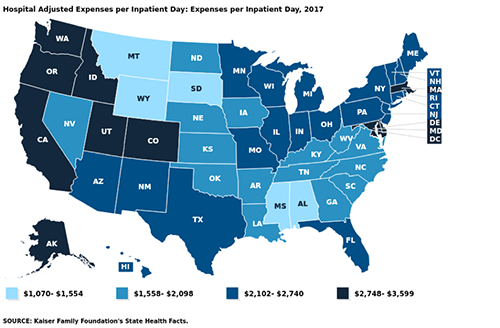How much does the average hospital spend/day to provide inpatient care? The numbers vary widely, but the latest statistics from Kaiser Family Foundation (KFF) State Health Facts show West Coast states incur the highest daily operating and non-operating inpatient costs.
This disparity in spending is unlikely to surprise medical laboratory executives working in hospital settings. They know firsthand that operating costs can vary from state-to-state and by hospital ownership type.
Oregon, California, and Washington are the most expensive three states overall for inpatient hospital care. However, the leaderboard changes when looking specifically at inpatient care at for-profit hospitals.
In the for-profit hospital category:
- North Dakota, South Dakota, and Alaska rack up the highest expenses/day.
- Idaho, California, and Oregon top the non-profit hospital segment.
Overall in the US, the average hospital incurs expenses of $2,424/inpatient day, the KFF reports.

While the average US hospital spends $2,424/day to deliver inpatient care, West Coast states have the highest hospital adjusted operating and non-operating expenses/inpatient day, according to a recent report from the Kaiser Family Foundation. Oregon hospitals top the spending list at $3,599/day. (Graphic copyright: Kaiser Family Foundation.)
AMA Annual Survey Rankings
Rankings are based on information from the 1999-2017 American Hospital Association Annual Survey, which includes all operating and non-operating expenses for registered US community hospitals. The figures are an estimate of the expenses incurred by a hospital to provide a day of inpatient care. They have been adjusted higher to reflect an estimate of the volume of outpatient services, according to the KFF. The numbers do not reflect actual charges or reimbursement for the care provided.
Most expensive average expenses/inpatient day:
- Oregon, $3,599
- California, $3,441
- Washington, $3,429
- Idaho, $3,119
- District of Columbia, $3,053
Least expensive average expenses/inpatient day:
- Montana, $1,070
- Mississippi, $1,349
- South Dakota, $1,505
- Wyoming, $1,520
- Alabama, $1,554
Most expensive non-profit hospitals/inpatient day:
- Idaho, $4,208
- California, $3,800
- Oregon, $3,546
- Washington, $3,500
- Colorado, $3,319
Least expensive non-profit hospitals/inpatient day:
- Mississippi, $1,365
- South Dakota, $1,519
- Iowa, $1,564
- Montana, $1,627
- Alabama, $1,723
Most expensive for-profit hospitals/inpatient day:
- North Dakota, $4,701
- South Dakota, $3,956
- Alaska, $3,280
- Nebraska, $3,031
- Wisconsin, $2,830
Least expensive for-profit hospitals/inpatient day:
- Maine, $1,055
- Maryland, $1,207
- West Virginia, $1,362
- Iowa, $1,558
- Arkansas, $1,619
Most expensive state/local government hospitals/inpatient day:
- Oregon, $4,062
- Connecticut, $3,979
- Washington, $3,312
- California, $3,217
- Utah, $3,038
Least expensive state/local government hospitals/inpatient day:
- Montana, $52
- South Dakota, $442
- Pennsylvania, $787
- Nebraska, $906
- Georgia, $917
Some Regions Pay Much More for Healthcare
The KFF report did not look at whether patients in states where hospitals incur the highest daily operating and non-operating expenses also pay the most for hospital services. Hospital charges vary widely, with many treatments costing far more in some regions than others.
In addition, health bills can vary at different hospitals in the same city or region. According to Healthcare.gov, the average total cost of a three-day hospital stay is about $30,000.
Adding to the confusion is the fact that hospital costs, billed charges, and the amounts paid by patients for services can be distinctly different amounts. Health insurance companies, for example, negotiate lower rates with hospitals and health systems for their plan enrollees. While patients without insurance are billed full price for services based on the hospital’s chargemaster.

Zack Cooper, PhD, Associate Professor of Health Policy and Economics at Yale University, told National Public Radio (NPR) that hospital consolidation is partly to blame for the wide variation in the price of hospital services within states and across the country. He says consolidation has eliminated competition in many markets. “Where one large hospital dominates the markets, that hospital is able to get higher prices,” Cooper maintains. “Hospitals have gotten increasingly powerful over time.” (Photo copyright: Yale University.)
CMS Final Rule Requires Pricing Transparency
As of Jan. 1, 2019, a new Centers for Medicare and Medicaid Services (CMS) rule went into effect aimed at making hospital pricing more transparent. The CMS is now requiring hospitals to publish chargemaster price lists online, rather than release those numbers to patients upon request.
However, healthcare advocates have questioned the rule’s impact on transparency. Posted hospital pricing information is often hard to access and difficult to comprehend. In addition, chargemaster prices typically do not represent the actual costs passed on to consumers.
“[The chargemaster] is the list price. When you go to buy a car, you have a manufacturer’s suggested retail price. This is basically what [the chargemaster] is,” Medical Contributor Natalie Azar, MD, told NBC News.
Meghan Nechrebecki, Founder and CEO of Health Care Transformation, told Debt.org that prevention is the best medicine for lower inpatient hospital bills.
“Prevention comes first,” Nechrebecki suggests. “Utilize the ambulatory care clinics. Go see your doctors and do what they recommend to keep yourself healthy. Eat well and exercise often. You will prevent many surgeries and hospitalizations.”
Sound advice. Nevertheless, clinical laboratories and anatomic pathology groups should take note of the federal government’s ongoing push for price transparency and prepare accordingly.
—Andrea Downing Peck
Related Information:
Hospital Adjusted Expenses/Inpatient Day
Hospital Adjusted Expenses/Inpatient Day by Ownership
HHS Takes New Steps in Secretary Azar’s Value-Based Agenda
That Surgery Might Cost You a Lot Less in Another Town
Protection from High Medical Costs
Hospitals to List Procedure Prices Under New Law: What You Need to Know
')}



